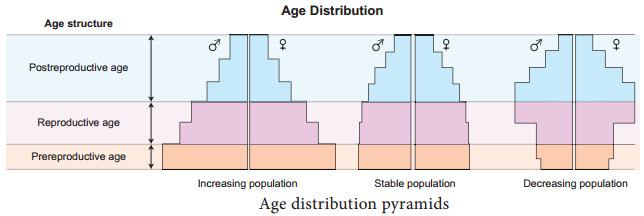Learninsta presents the core concepts of Biology with high-quality research papers and topical review articles.
Population Age Distribution
The proportion of the age groups (pre-reproductive, reproductive and post reproductive) in a population is its age distribution attribute. This determines the reproductive status of the population at the given time and is an indicator of the future population size.
Usually a rapidly growing population will have larger proportion of young individuals. A stable population will have an even distribution of various age classes. A declining population tends to have a larger proportion of older individuals (Fig. 10.10).

The global median age has increased from 21.5 years in 1970 to over 30 years in 2019. The global population breakdown by age shows that a quarter (26%) are younger than 14 years, 8% are older than 65, while half of the world population is the working age bracket between 25 and 65.
Age structure reflects the proportions of individuals at different life stages. This variable is an important indicator of population status. Stable populations usually have relatively more individuals in reproductive age-classes.
The younger working-age population, ages 18 to 44, represented 112.8 million persons (36.5 percent). The older working-age population, ages 45 to 64, made up 81.5 million persons (26.4 percent). Finally, the 65 and over population was 40.3 million persons (13.0 percent).